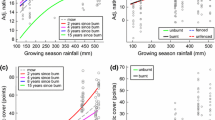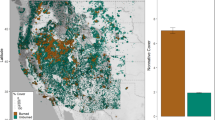Abstract
The 2002 Hayman Fire burned with mixed severity across 55,800 ha of montane Colorado forest, including pre-existing plots that were originally measured for understory plant composition and cover in 1997. We examined the influence of the Hayman Fire on exotic plants by remeasuring these plots annually from 2003 to 2007. We found that (1) exotic richness and cover generally increased as fire severity and time since fire increased; (2) the exotic species present in a plot before the fire were also largely present in the plot postfire, regardless of fire severity; (3) most of the new postfire species in a plot were present elsewhere in the study area before the fire, although some new species were truly new invaders that were not found in prefire surveys; (4) lightly burned riparian forests were not more susceptible to exotic invasion than surrounding uplands that burned with similar severity; and (5) native and exotic richness and cover were positively correlated or uncorrelated for all fire severities and years. Our findings indicate that exotics were stimulated by the Hayman Fire, especially in severely burned areas. However, exotic richness and cover remain low as of 2007, and correlations between native and exotic richness and cover suggest that exotics have not yet interfered with native understory development. Therefore, we conclude that exotic plants are not a major ecological threat at present, but recommend that monitoring be continued to evaluate if they will pose a threat in future years.




Similar content being viewed by others
References
Alvarez M, Cushman JH (2002) Community-level consequences of a plant invasion: effects on three habitats in coastal California. Ecol Appl 12:1434–1444
Brown RL, Peet RK (2003) Diversity and invasibility of southern Appalachian plant communities. Ecology 84:32–39
Brown TJ, Hall BL, Westerling AL (2004) The impact of twenty-first century climate change on wildland fire danger in the western United States: an applications perspective. Climatic Change 62:365–388
Chong G, Stohlgren T, Crosier C et al (2003) Key invasive nonnative plants. In: Graham RT (ed) Hayman fire case study. Gen Tech Rep RMRS-GTR-114. USDA Forest Service, Rocky Mountain Research Station, Fort Collins, pp 244–249
Crawford JA, Wahren CHA, Kyle S et al (2001) Responses of exotic plant species to fires in Pinus ponderosa forests in northern Arizona. J Veg Sci 12:261–268
DeFerrari CM, Naiman RJ (1994) A multi-scale assessment of the occurrence of exotic plants on the Olympic Peninsula, Washington. J Veg Sci 5:247–258
DiTomaso JM, Kyser GB, Hastings MS (1999) Prescribed burning for control of yellow starthistle (Centaurea solstitialis) and enhanced native plant diversity. Weed Sci 47:233–242
Dodge RS, Fulé PZ, Sieg CH (2008) Dalmatian toadflax (Linaria dalmatica) response to wildfire in a southwestern USA forest. Ecoscience 15:213–222
Doyle KM, Knight DH, Taylor DL et al (1998) Seventeen years of forest succession following the Waterfalls Canyon Fire in Grand Teton National Park, Wyoming. Int J Wildland Fire 8:45–55
Ferguson DE, Craig CL, Schneider KZ (2007) Spotted knapweed (Centaurea biebersteinii DC) response to forest wildfires on the Bitterroot National Forest, Montana. Northwest Sci 81:138–146
Flora of North America Editorial Committee (1993) Flora of North America North of Mexico. Oxford University Press, New York, New York
Floyd ML, Hanna DD, Romme WH et al (2006) Predicting and mitigating weed invasions to restore natural post-fire succession in Mesa Verde National Park, Colorado, USA. Int J Wildland Fire 15:247–259
Fornwalt PJ, Kaufmann MR, Huckaby LS et al (2003) Non-native plant invasions in managed and protected ponderosa pine/Douglas-fir forests of the Colorado Front Range. For Ecol Manag 177:515–527
Fornwalt PJ, Kaufmann MR, Huckaby LS et al (2009) Effects of past logging and grazing on understory plant communities in a montane Colorado forest. Plant Ecol 203:99–109
Freeman JP, Stohlgren TJ, Hunter ME et al (2007) Rapid assessment of postfire plant invasions in coniferous forests of the western United States. Ecol Appl 17:1656–1665
Graham RT (2003) Hayman fire case study. Gen Tech Rep RMRS-GTR-114. USDA Forest Service, Rocky Mountain Research Station, Fort Collins
Gross KL, Werner PA (1978) The biology of Canadian Weeds. Verbascum thapsus L. and V. blattaria L. Can J Plant Sci 58:401–413
Heckmann KE, Manley PN, Schlesinger MD (2008) Ecological integrity of remnant montane forests along an urban gradient in the Sierra Nevada. For Ecol Manag 255:2453–2466
Huisinga KD, Laughlin DC, Fulé PZ et al (2005) Effects of an intense prescribed fire on understory vegetation in a mixed conifer forest. J Torrey Bot Soc 132:590–601
Hunter ME, Omi PN, Martinson EJ et al (2006) Establishment of non-native plant species after wildfires: effects of fuel treatments, abiotic and biotic factors, and post-fire grass seeding treatments. Int J Wildland Fire 15:271–281
Kaufmann MR, Regan CM, Brown PM (2000) Heterogeneity in ponderosa pine/Douglas-fir forests: age and size structure in unlogged and logged landscapes of central Colorado. Can J For Res 30:698–711
Keeley JE (2006) Fire management impacts on invasive plants in the western United States. Cons Biol 20:375–384
Keeley JE, McGinnis TW (2007) Impact of prescribed fire and other factors on cheatgrass persistence in a Sierra Nevada ponderosa pine forest. Int J Wildland Fire 16:96–106
Keeley JE, Lubin D, Fotheringham CJ (2003) Fire and grazing impacts on plant diversity and alien plant invasions in the southern Sierra Nevada. Ecol Appl 13:1355–1374
Keeley JE, Fotheringham CJ, Keeley MB (2005) Determinants of post-fire recovery and succession in mediterranean-climate shrublands of California. Ecol Appl 15:1515–1534
Keeley JE, Allen CD, Betancourt J et al (2006) A 21st century perspective on postfire seeding. J Forest 104:103–104
Kivilaan A, Bandurski RS (1981) The one-hundred year period for Dr. Beal’s seed viability experiment. Am J Bot 68:1290–1292
Klinger R, Underwood EC, Moore PE (2006) The role of environmental gradients in non-native plant invasion into burnt areas of Yosemite National Park, California. Diversity Distrib 12:139–156
Knapp PA (1996) Cheatgrass (Bromus tectorum L.) dominance in the Great Basin Desert: history, persistence, and influences to human activities. Glob Environ Chang 6:37–52
Koniak S (1985) Succession in pinyon-juniper woodlands following wildfire in the Great Basin. Great Basin Naturalist 45:556–566
Laughlin DC, Bakker JD, Stoddard MT et al (2004) Toward reference conditions: wildfire effects on flora in an old-growth ponderosa pine forest. For Ecol Manag 199:137–152
Mack RN, Simberloff D, Lonsdale WM et al (2000) Biotic invasions: causes, epidemiology, global consequences, and control. Ecol Appl 10:689–710
Minchinton TE, Simpson JC, Bertness MD (2006) Mechanisms of exclusion of native coastal marsh plants by an invasive grass. J Ecol 94:342–354
Nelson CR, Halpern CB, Agee JK (2008) Thinning and burning result in low-level invasion by nonnative plants but neutral effects on natives. Ecol Appl 18:762–770
Parker IM, Mertens SK, Schemske DW (1993) Distribution of seven native and two exotic plants in a tallgrass prairie in southeastern Wisconsin: the importance of human disturbance. Am Midl Nat 130:43–55
Robichaud P, MacDonald L, Freeouf J et al (2003) Postfire rehabilitation of the Hayman Fire. In: Graham RT (ed) Hayman fire case study. Gen Tech Rep RMRS-GTR-114. USDA Forest Service, Rocky Mountain Research Station, Fort Collins, pp 293–313
Smith LM II, Kok LT (1984) Dispersal of musk thistle (Carduus nutans) seeds. Weed Sci 32:120–125
Stickney PF, Campbell RB Jr (2000) Data base for early postfire succession in northern Rocky Mountain forests. Gen Tech Rep RMRS-GTR-61CD. USDA Forest Service, Rocky Mountain Research Station, Ogden
Stohlgren TJ, Falkner MB, Schell LD (1995) A modified-Whittaker nested vegetation sampling method. Vegetatio 117:113–121
Stohlgren TJ, Binkley D, Chong GW et al (1999) Exotic plant species invade hot spots of native plant diversity. Ecol Monogr 69:25–46
Stohlgren TJ, Guenther DA, Evangelista PH et al (2005) Patterns of plant species richness, rarity, endemism, and uniqueness in an arid landscape. Ecol Appl 15:715–725
Thuiller WD, Richardson DM, Midgley GF (2007) Will climate change promote alien plant invasions? In: Nentwig W (ed) Ecological studies, volume 193: biological invasions. Springer-Verlag, Berlin, pp 197–211
Turner MG, Romme WH, Gardner RH (1999) Prefire heterogeneity, fire severity, and early postfire plant reestablishment in subalpine forests of Yellowstone National Park, Wyoming. Int J Wildland Fire 9:21–36
USDA (2008) The PLANTS database. USDA National Plant Data Center, Baton Rouge, Louisiana. http://www.plants.usda.gov. Accessed 30 Dec 2008
USDA Forest Service (1992) Soil survey of Pike National Forest, eastern part, Colorado. USDA Forest Service, Rocky Mountain Region and Soil Conservation Service, Lakewood, CO
USDA Forest Service (2008) Fire effects information system. USDA Forest Service, Rocky Mountain Research Station, Missoula, MT. http://www.fs.fed.us/database/feis. Accessed 30 Dec 2008
USDOI and USDA Forest Service (2009) Healthy forests report: FY 2008 Accomplishments. http://www.forestsandrangelands.gov/reports/documents/healthyforests/2008/healthy_forests_report_fy2008.pdf. USDOI and USDA Forest Service, Washington, DC. Accessed 4 Dec 2009
Walker LR, Vitousek PM (1991) An invader alters germination and growth of a native dominant tree in Hawai’i. Ecology 72:1449–1455
Weaver SE, Downs MP (2003) The biology of Canadian weeds. 122. Lactuca serriola L. Can J Plant Sci 83:619–628
Westerling AL, Hidalgo HG, Cayan DR et al (2006) Warming and earlier spring increase western U.S. forest wildfire activity. Science 313:940–943
Whisenant SG, Uresk DW (1990) Spring burning Japanese brome in a western wheatgrass community. J Range Manag 43:205–208
Willson GD, Stubbendieck J (1997) Fire effects on four growth stages of smooth brome (Bromus inermis Leyss.). Nat Areas J 17:306–312
Wood DM, del Moral R (2000) Seed rain during early primary succession on Mount St. Helens, Washington. Madrono 47:1–9
Zouhar K, Smith JK, Sutherland S, et al (2008) Wildland fire in ecosystems: fire and nonnative invasive plants. Gen Tech Rep RMRS-GTR-42-vol-6. USDA Forest Service, Rocky Mountain Research Station, Odgen, UT
Acknowledgments
This research project was funded by the Joint Fire Science Program (Project Numbers 03-2-3-08 and 04-2-1-118), NASA (Project Number NRA-03-OES-03), and the USDA Forest Service Rocky Mountain Research Station. We gratefully acknowledge Stephanie Asherin, Allison Grow, Rebecca Hemmerling, Micky McNaughton, Jill Oropeza, Lisa Schell, and Betsy Smith for their assistance with plant surveys, and Rebecca Hemmerling, Rick Shory and Jennifer Ventker for help with data management and specimen archiving. We also thank Laurie Huckaby, William Romme, and two anonymous reviewers for their useful comments on earlier drafts of the article, and Rudy King and Jim zumBrunnen for statistical advice.
Author information
Authors and Affiliations
Corresponding author
Additional information
This paper was written and prepared by US Government employees on official time, and therefore it is in the public domain and not subject to copyright.
Rights and permissions
About this article
Cite this article
Fornwalt, P.J., Kaufmann, M.R. & Stohlgren, T.J. Impacts of mixed severity wildfire on exotic plants in a Colorado ponderosa pine–Douglas-fir forest. Biol Invasions 12, 2683–2695 (2010). https://doi.org/10.1007/s10530-009-9674-2
Received:
Accepted:
Published:
Issue Date:
DOI: https://doi.org/10.1007/s10530-009-9674-2




